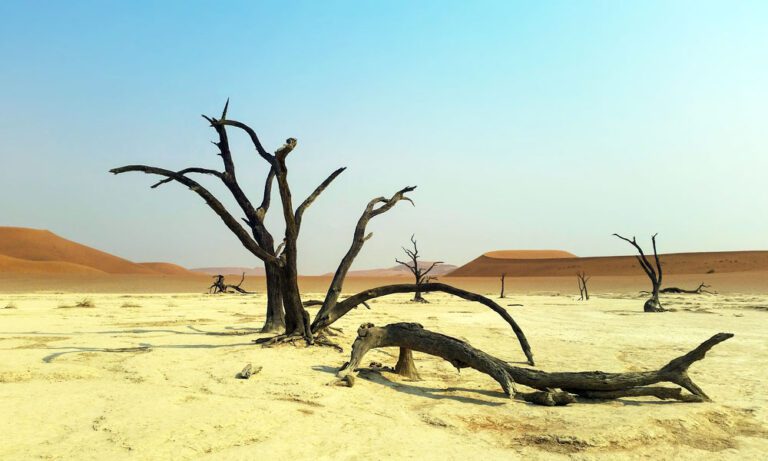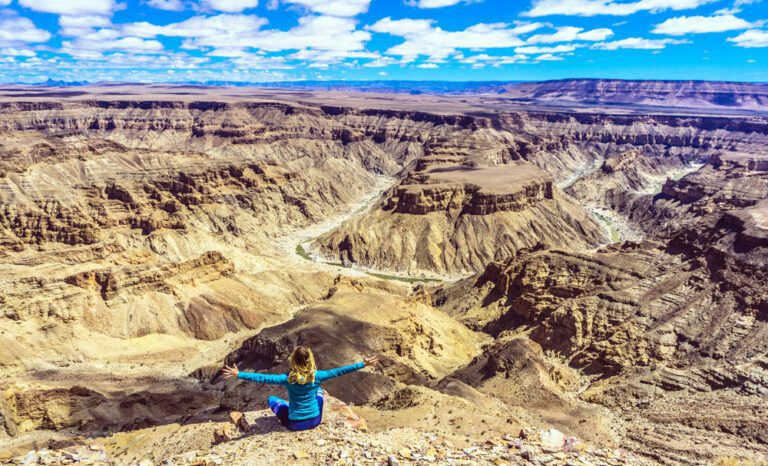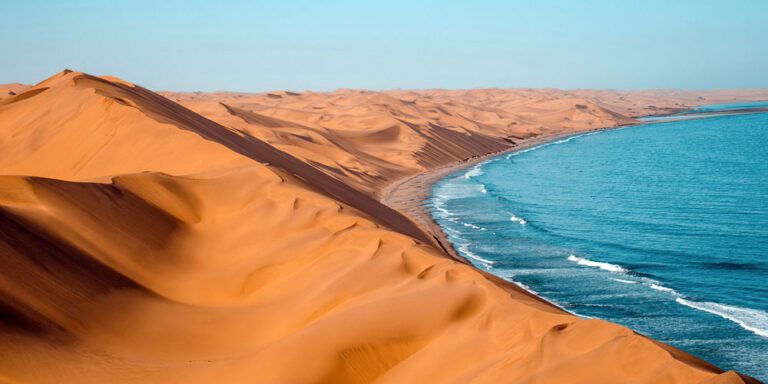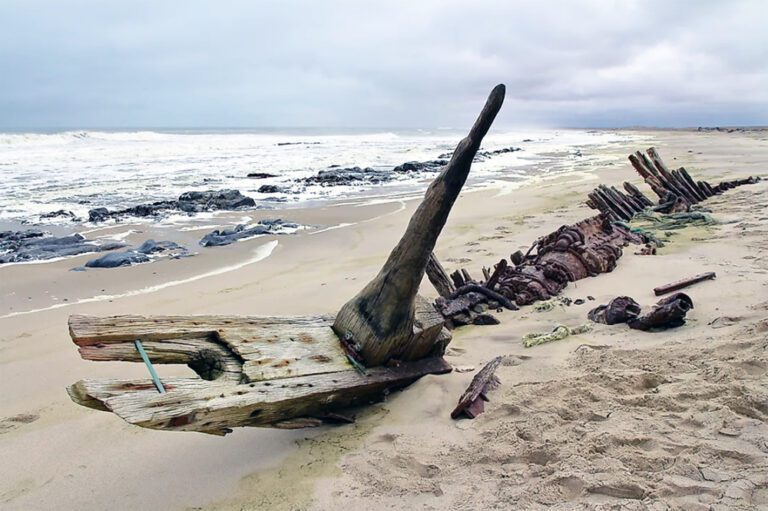Lost in the Sands: The Secrets of Sossusvlei

Nestled in the heart of the Namib Desert, Sossusvlei is a breathtaking oasis of towering red sand dunes, stark landscapes, and ancient mysteries. This unique region boasts some of the highest dunes in the world, sculpted by the wind into mesmerizing shapes and patterns.
Sossusvlei’s otherworldly beauty has long captivated travelers, photographers, and adventurers alike, making it one of Namibia’s most iconic destinations.
In this blog post, we will embark on a journey to unveil the secrets of Sossusvlei, delving into its geological wonders, rich history, and diverse wildlife. Through our exploration, we will uncover the hidden gems and lesser-known treasures that make Sossusvlei a true desert paradise.
Join us as we venture into the sands and unlock the mysteries that await in the heart of Namibia’s enchanting desert oasis.
The Geological Wonders of Sossusvlei

Formation and Characteristics of the red sand dunes
The striking red sand dunes of Sossusvlei are its most famous feature. The wind has shaped these dunes for millions of years by carrying sand from the Orange River and dropping it in the Namib Desert. The vibrant red color of the dunes comes from the high iron content in the sand, which oxidizes and creates a rich, rusty hue.
The iconic Deadvlei and its ancient dead trees
Another iconic sight in Sossusvlei is Deadvlei, a surreal, white clay pan surrounded by towering dunes. This ancient lakebed, now parched and cracked, is home to a haunting forest of dead camel thorn trees. These trees are about 600 years old. The dry climate has preserved them demonstrating how the region’s environment keeps changing.
Deadvlei is a favorite spot for photographers, who are drawn to the stark contrast between the bleached clay pan, the dark skeletons of the trees, and the vibrant red dunes.
Hidden gems: lesser-known formations and landscapes
While the red dunes and Deadvlei are the most famous landmarks in Sossusvlei, there are also many lesser-known geological wonders waiting to be discovered. The area has several hidden valleys, rocks, and fossilized dunes, and visitors can explore and enjoy the beauty of the desert landscape.
One such hidden gem is the Sesriem Canyon, a narrow gorge carved by the Tsauchab River over millions of years. The canyon offers a unique perspective on the desert’s geological history and serves as a refreshing oasis, with pools of water that collect during the rainy season.
A Journey Through Time

Historical significance of the region
The Sossusvlei region holds great historical significance, with its shifting sands preserving the stories of the people and creatures who have called this harsh environment home. Historians, archaeologists, and travelers have been fascinated by the region. They have found proof of people living here thousands of years ago.
Ancient civilizations and their connection to Sossusvlei
Ancient civilizations, such as the San people, have had a deep connection to the Sossusvlei region. The hunter-gatherers adjusted to the tough desert conditions. They survived using their deep understanding of the land and its resources.
Rock art and archaeological remains found throughout the area bear witness to their presence and provide a glimpse into the lives of these early inhabitants. The San people’s history and culture are intertwined with Sossusvlei, and their descendants still live in Namibia today, preserving their unique heritage and traditions.
The Role of Sossusvlei in Namibia’s modern history
In modern history, Sossusvlei has played an important role in shaping Namibia’s identity. In the colonial era, the region belonged to German South West Africa. You can still see abandoned buildings and infrastructure from that time.
Today, Sossusvlei is a symbol of Namibia’s natural beauty and resilience, attracting visitors from all over the world to marvel at its unique landscape. The region is becoming a popular tourist spot. This brings money to local communities and helps development. It also preserves culture and nature for future generations.
Flora and Fauna

The remarkable plants that thrive in the harsh desert environment
Despite the harsh desert conditions, a variety of remarkable plants have adapted to thrive in Sossusvlei. The camel thorn tree is one example. It can grow 60 feet tall and has long roots. These roots let it get water from deep underground.
The famous quiver tree, with its unique, branching structure, is another example of a plant that has adapted to survive the desert climate. The plants help the wildlife survive by providing food and shelter in a barren area.
The unique and diverse animal species found in the region
The animal species found in Sossusvlei are as unique and diverse as the landscape itself. The region is home to various desert-adapted mammals, such as oryx, springbok, and jackals, which have evolved to withstand extreme temperatures and scarce water supply.
The dunes are home to small animals like reptiles, insects, and rodents. Birdlife is abundant in the area, with species like the dune lark, raptors, and sandgrouse making their homes in Sossusvlei.
Conservation efforts and the importance of protecting Sossusvlei’s ecosystem
Protecting Sossusvlei’s fragile ecosystem is crucial for the survival of its diverse flora and fauna. Conservation efforts, including the establishment of the Namib-Naukluft National Park, help to preserve the area’s natural beauty and prevent habitat loss due to human interference.
Local and international organizations work to watch and control wildlife numbers. This keeps the desert ecosystem in balance. As a visitor to Sossusvlei, it is essential to be mindful of your impact on the environment and to follow guidelines that promote responsible tourism, allowing future generations to enjoy this remarkable desert paradise.
Exploring Sossusvlei’s Secrets

The best ways to navigate the vast dunes: 4×4, hot air balloon, or on foot
There are several exciting ways to navigate the vast dunes of Sossusvlei and discover its hidden treasures. Traveling by 4×4 is a popular choice, allowing you to cover more ground while experiencing the thrill of driving over the undulating dunes.
For a bird’s-eye view of the stunning landscape, a hot air balloon ride offers an unforgettable experience, as you float above the sea of red sand and marvel at the patterns below. If you prefer a more intimate connection with nature, exploring Sossusvlei on foot lets you experience the desert up close and personal, feeling the warm sand between your toes as you climb the towering dunes.
Must-see spots and hidden gems to visit
While Deadvlei and the red dunes are must-see spots, there are also many hidden gems to visit in Sossusvlei. The previously mentioned Sesriem Canyon is a lesser-known attraction, offering a refreshing break from the desert heat.
Another hidden gem is the Fairy Circles, mysterious circular patches of bare soil surrounded by grass that have puzzled scientists for decades. Don’t forget to explore the quieter dunes where you can enjoy a serene moment away from the crowds.
Tips for capturing stunning photographs of the landscape
Sossusvlei’s landscape offers countless opportunities for capturing stunning photographs. To make the most of your shots, plan to visit during the early morning or late afternoon when the sun’s low angle creates dramatic shadows and emphasizes the dunes’ rich colors.
Experiment with different perspectives, such as close-ups of the sand’s texture or wide-angle shots that showcase the vastness of the desert. And, of course, be patient – sometimes, the perfect photo opportunity reveals itself when you least expect it.
Responsible Tourism in Sossusvlei

The Impact of Tourism on the Environment and Local Communities
While tourism in Sossusvlei has brought many benefits, it also has the potential to negatively impact the environment and local communities. Increased visitation can lead to habitat disturbance, pollution, and strain on natural resources like water. Moreover, if not managed carefully, tourism may contribute to the erosion of local culture and traditions.
Guidelines for sustainable and responsible travel in the region
To ensure that your visit to Sossusvlei is sustainable and responsible, it is essential to follow certain guidelines. When exploring the region, always stay on designated trails to minimize your impact on the delicate desert ecosystem.
Be mindful of your water usage and dispose of waste properly, as resources in the desert are scarce. Respect the local culture and customs by dressing modestly and seeking permission before photographing people or their homes.
Supporting local businesses and community-based tourism initiatives
Supporting local businesses and community-based tourism initiatives is another way to make your trip to Sossusvlei more responsible. By choosing locally-owned lodges, purchasing handicrafts directly from artisans, and hiring local guides, you can contribute to the well-being of the communities that call Sossusvlei home.
Participating in community-based tourism projects, such as cultural experiences or conservation initiatives, will enrich your visit.
Planning Your Trip to Sossusvlei

Best time of year to visit
The best time of year to visit Sossusvlei depends on your preferences. The cooler months of May to October offer more comfortable temperatures for exploring the dunes, with daytime highs ranging from 70°F to 85°F.
However, this is also the high season, so expect more visitors during this time. The summer months from November to April are hotter, with temperatures reaching over 100°F, but there are fewer tourists and occasional thunderstorms can create dramatic skies and a more vibrant landscape.
Accommodation options: lodges, campsites, and luxury stays
Sossusvlei offers a range of accommodation options to suit different tastes and budgets. To get a real desert experience, try staying at a lodge or campsite near the park entrance. These options often include meals and guided tours, providing an immersive stay in the heart of the desert.
For a luxurious stay, choose from many high-end lodges and tented camps in the area. They offer private plunge pools, air conditioning, and fine dining.
Essential packing list and practical tips for a successful journey
When packing for Sossusvlei, bring:
Additionally, bring a light jacket or sweater for the cooler evenings and early mornings. It’s also a good idea to carry a small first-aid kit and your medications as you will be far from medical facilities while in the desert.
Conclusion
In this blog, we’ve unveiled the many secrets and wonders of Sossusvlei, from its awe-inspiring red dunes and the haunting beauty of Deadvlei to the rich history and diverse wildlife that call this unique desert landscape home. We’ve also shared tips for exploring the region responsibly, capturing stunning photographs, and planning the perfect trip to this enchanting corner of Namibia.
Now that you’ve discovered the magic of Sossusvlei, it’s time to experience it for yourself. Venture into the heart of the Namib Desert and uncover the mysteries that lie beneath the shifting sands. As you immerse yourself in the breathtaking beauty of Sossusvlei, you’ll create unforgettable memories and gain a deeper appreciation for the wonders of our natural world. Happy exploring!






